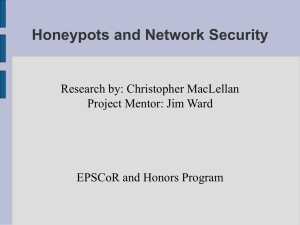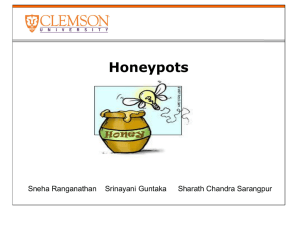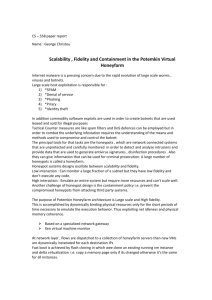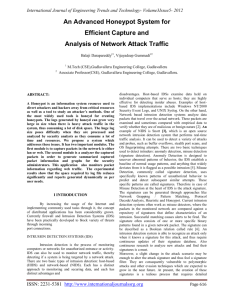Honeypot: A supplemented active defense system for network security
advertisement
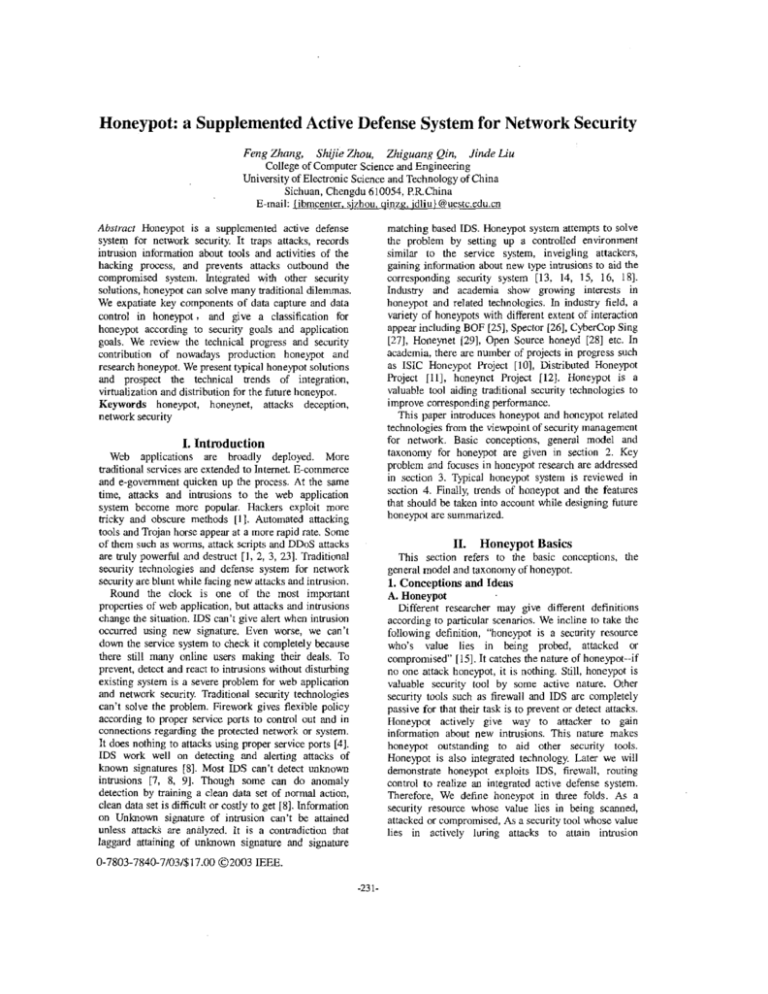
Honeypot: a Supplemented Active Defense System for Network Security
Feng Zhang,
Shijie Zhou. Zhiguang Qin, Jinde Liu
College of Computer Science and Engineering
University of Electronic Science and Technology of China
Sichuan, Chengdu 610054, P.R.China
E-mail: libmcenter. sizhou. qinzr, idliu}@uestc,edu.cn
Abstract Honeypot is a supplemented active defense
system for network security. It traps attacks, records
intrusion information about tools and activities of the
hacking process, and prevents attacks outbound the
compromised system. Integrated with other security
solutions, honeypot can solve many traditional dilemmas.
We expatiate key components of data capture and data
control in honeypot, and give a classification for
honeypot according to security goals and application
goals. We review the technical progress and security
contribution of nowadays production honeypot and
research honeypot. We present typical honeypot solutions
and prospect the technical trends of integration,
virtualization and distribution for the future honeypot.
Keywords honeypot, honeynet, attacks deception,
network security
matching based IDS. Honeypot system attempts to solve
the problem by setting up a controlled environment
similar to the service system, inveigling attackers,
gaining information about new type intrusions to aid the
corresponding security system [13, 14, 15, 16, 181.
Industry and academia show growing interests in
honeypot and related technologies. In industry field, a
variety of honeypots with different extent of interaction
appear including BOF [25],Spector [26],CyberCop Sing
[27], Honeynet [29], Open Source honeyd [28j etc. In
academia, there are number of projects in progress such
as ISIC Honeypot Project [lo], Distributed Honeypot
Project [ I l l , honeynet Project [12]. Honeypot is a
valuable tool aiding traditional security technologies to
improve corresponding performance.
This paper introduces honeypot and honeypot related
technologies from the viewpoint of security management
for network. Basic conceptions, general model and
taxonomy for honeypot are given in section 2. Key
problem and focuses in honeypot research are addressed
in section 3. Typical honeypot system is reviewed in
section 4. Finally, trends of honeypot and the features
that should be taken into account while designing future
honeypot are summarized.
I. Introduction
Web applications are broadly deployed. More
traditional services are extended to Internet. E-commerce
and e-government quicken up the process. At the same
time, attacks and intrusions to the web application
system become more popular. Hackers exploit more
tricky and obscure methods [I]. Automated attacking
tools and Trojan horse appear at a more rapid rate. Some
of them such as worms, attack scripts and DDoS attacks
are truly powerful and destruct [ I , 2, 3, 231. Traditional
security technologies and defense system for network
security are blunt while facing new attacks and intrusion.
Round the clock is one of the most important
properties of web application, hut attacks and intrusions
change the situation. IDS can’t give alert when intrusion
occurred using new signature. Even worse, we can’t
down the service system to check it completely because
there still many online u s a s making their deals. To
prevent, detect and react to intrusions without disturbing
existing system is a severe problem for web application
and network security Traditional security technologies
can’t solve the problem. Firework gives flexible policy
according to proper service ports to control out and in
connections regarding the protected network or system.
It does nothing to attacks using proper service ports [4].
IDS work well on detecting and alerting attacks of
known signatures [8]. Most IDS can’t detect unknown
intrusions [7, 8, 91. Though some can do anomaly
detection by training a clean data set of normal action,
clean data set is difficult or costly to get [8]. Information
on Unknown signature of intrusion can’t be attained
unless attacks are analyzed. It is a contradiction that
laggard attaining of unknown signature and signature
11.
Honeypot Basics
This section refers to the basic conceptions, the
general model and taxonomy of honeypot.
1. Conceptions a n d Ideas
A. Honeypot
Different researcher may give different definitions
according to particular scenarios. We incline to take the
following definition, “honeypot is a security resource
who’s value lies in being probed, attacked or
compromised” [15]. It catches the nature of honeypot--if
no one attack honeypot, it is nothing. Still, honeypot is
valuable security tool by some active nature. Other
security tools such as firewall and IDS are completely
passive for that their task is to prevent or detect attacks.
Honeypot actively give way to attacker to gain
information about new intrusions. This nature makes
honeypot outstanding to aid other security tools.
Honeypot is also integrated technology. Later we will
demonstrate honeypot exploits IDS, firewall, routing
control to realize an integrated active defense system.
Therefore, We define honeypot in three folds. As a
security resource whose value lies in being scanned,
attacked or compromised, As a security tool whose value
lies in actively luring attacks to attain intrusion
0-7803-7840-7/03/$17.00 0 2 0 0 3 IEEE.
-231-
information and improving performance of other security
tools such as IDS, As one technology whose value lies in
being an alternative methods for network security.
Honeypot differ according to different use.'It could be
an emulated application, a full functional operating
system with default configuration or an actual net
including different OS and applications, even an
emulated network on a single machine. We will cover
different kinds of honeypot in section 4.
One basic assumption for honeypot is that all
connections outward and inward honeypot are
considered conspicuous [lS, 161. That is rational for that
honeypot itself doesn't provide public product services,
and that Connections inbound and outbound honeypot
are probably initiated from attacker to probe or attack the
target. There maybe some mistyping IP but the chance is
little.
B. Production Honeypot and Research Honeypot
Traditional honeypot is used to protect network of
corporation. production honeypot is aimed to do so.
Always does product honeypot come in company with
production systems such as mail server and www server.
They protect the target system by deceiving and
detecting attacks, giving alert to administrator.
Research honeypot is primarily for learning new
attacking methods and tools, gaining new information
about attacks though it can be used for production
honeypot. It provides more interactive chances for
attackers and takes more risks being controlled at the
same time. Research honeypot take an effective data
control mechanism to prevent from being a jump to
attack other computer system [16].
C. Honeynet
Honeynet has particular meaning comesponding to
honeypot. Firstly, it is mainly used for research work.
Secondly, there me multiple system in a honeynet. All
systems placed within the Honeynet are standard
production systems. Nothing is emulated nor is anything
done to make the systems less secure. Honeynet is more
interactive than honeypot and strongly resemble an
actual net (it is truly an net with router, workstations,
popular operationg systems and default configured
service installed in default signature). Honeynet project
focuses on honeynet related technologies. This
organization give many useful advices making honeynet
easier to deploy and difficult to detect. Honeynet and
honeypot advance together by sharing attacks deceptions,
data capture and data control technology.
D. Data Control and Data Capture
Data control and data capture are two essential
requirements lie in all kinds of honeypot. The main task
of honeypot is luring attacks and gaining intrusion
information while preventing being used to attack other
system. Data capture fulfill recording intrusions and
attacks to honeypot. Data control measures up to prevent
the compromised honeypot being an gangplank and
protect the record data. Research works on data control
refer to connection control and routing control
technologies, and that data capture is a layered
architecture to record data from link layer, IP layer and
application layer. Related fields cover firewall, router
and IDS.
2. General Model for Honeypot
In 2.1.4, we interpret two essential requirements of
honeypotdata control and data caputure. the following
model fulfills the basic two requirements and performs
effectively.
We deploy IDS component, firework component,
router control component, log component
In the
general model, target OS and applications with default
configured. AU of them cooperate one another to form a
honeypot system. We will analyze it how to work and
fulfill two requirements.
s,.lll
Sll I . C*.~..l
=*dc,
re,
Data control includes connection control and routing
control. Firewall component (connection control)
controls the outbound and inbound connections.
Certainly, we allow all the inbound connections to the
honeypot or we can't trap any attacks. Outbound
connections should be controlled because connections
initiated from honeypot is probably he used to attack
other computer system. Alternative measures could he
taken, just count and setup an threshold for outbound
connections, add intelligence by analyzing activities of
applications respectively to determine if an outbound
connection should be blocked. Routing conaol
component is the second layer for access control. It
blocks any non-honeypot-IP packets so as to prevent
most IP spoofed attacks to other system. Routing control
component also supplements firewall component to
control outbound connections.
Data capture uses a 3-layer hierarchy to capture and
store data. Firewall component is the first layer (IP layer)
to capture outbound and inbound connection data. All the
connections are considered suspicious. These data are
critically useful when watching and analyzing attack
process. Second layer of data capture is IDS component,
which captures all the network activities of honeypot in
link layer. It lies in the same network with the target
honeypot system and gather data in a hidden way. The
third layer is log component which logs all the activities
of the honeypot OS in application layer. Log data are
stored remotely in strong access controlled log server.
Experienced attacker would discover the remote log and
try to destroy log server. It need more advanced skills to
succeed compromising the security enhanced log server.
-232-
Even if attacker really hack the log server, we have
firewall and IDS component record the attacking
process.
Layered data control and data capture gives attackers
great flexibility to interact with honeypot and provides a
more secure way protecting intrusion process data. Data
control and data capture can be deployed in a distributed
layered net environment for secure reason or deployed in
one single machine for portability.
Incident team can take off-line the reaction honeypot and
investigate in detail what failed, what damage was done,
what entrance of attacker used and what he did. Lessons
learned from reaction honeypot can be used to identify
faults and recovery production system.
Research honeypot focuses threats information
including motives, tools, methods and skills. It is a
platform with common vulnerabilities and OS holes to
attain information from the opponent. Unlike the above
three honeypot, research honeypot doesn’t always
company with production system but give attacker great
flexibility. The goal of research honeypot is security
research. Researchers analyze new attacking tools as
well as worms extracted from recording information.
Remedies or solutions can be applied to enhance normal
system security.
One honeypot maybe carry several responsibilities of
both security goal and research goal. We know. that
prevention, detection and reaction relate one another in
security life cycle. Research honeypot can be modified
and adapted to particular security life cycle too.
Honeypot can be classified according to application
goals. The kind of application-oriented honeypot
dedicate to solving a certain application security problem.
The following are several application-oriented solutions.
A case in point is antispam honeypot, which filters spam
without eliminating legitimate mail [ZO, 211: DOS and
DDoS honeypot detect attacks by signature matching and
actively directing attacking packets to honeypot through
transparent packet forwarder [ZZ]. Worm honeypot traps
a robot intruder indefinitely by manipulating the TCP
session parameters. Almost no intruder .could escape
1241.
3. Honeypot Taxonomy
honeypot can be classified by security goals or
application goals. Related research work focuses
different fields accordingly. We break honeypot into four
broad categories according to security goals, prevention,
detection, reaction and research. The fust three focuses
different cycles in security, while the last one focuses the
whole attacking process.
Prevention honeypot stops attacker compromising
production system indirectly. It applies effective attacks
deception methods such as IP address deception (using
multi-homed capability in a single LAN interface),
network traffic simulation and information deception.
Hacker wastes time attacking honeypot system instead of
production system. In this way, honeypot deters attacks
in and protects production system from being comprised.
It’s true that new automated attacks and worms can
infiltrate the production system. honeypot still more
easier to capture the auto-rooters and worms because of
know vulnerabilities to provide information in advance.
Detection honeypot gives alert when attack occurs.
Main difference between detection honeypot and IDS
lies in that honeypot detects compromises by virtue of
system activities while IDS compares intrusion mode
with known signature. So detection honeypot is effective
in detecting new or unknown attacks. The other
contribution to intrusion detection is that it can reduce
both false positive rate and false negative rate. False
positives are alerts that were generated when IDS sensor
recognizes ‘‘signatures’’ are intrusions but are valid in
reality. False negatives are opposite meaning, IDS fails
detects valid intrusions. Reducing false positive rate is a
big problem IDS facing. Outbound and inbound
honeypot connections can be attacks to honeypot or
attacks initiated from compromised system. Thus alert
generated from honeypot is lower false positive rate and
false negative rate. Detection honeypot can’t be deployed
solely because honeypot itself would be comprised and
controlled. Detection honeypot can be a powerful tool
supplements IDS in attacks detection.
Reaction honeypot is a companion system for
production system. It provides a environment similar to
production system for taking measures to find the cause
and patch vulnerabilities after the production system is
attacked and compromised. It is always a great loss to
take production system off-line for a full analysis after
intrusion occurs, but we can’t have a completely check
on on-line target system for that there are active users
making their deals and perhaps the attacker is just active
in system. Reaction honeypot removes the difficulties.
111. Reseamh Focus
The total goal of improvement is ,making honeypot
easier to deploy and more diffcult to detect. qesent
research points to the following fields.
, ,
1. Detection Method
Tracking attacker’s activity instead of merely counting
their outbound connections. An activity is asserted to be
an attack according to actual ,activity ‘in honeypot.
Assertion is made basing on common-use command
sequence or tools such as tip, telnet. Data mining method
of sequence analysis is introduced to add intelligence for
attacks detection [9].
2. Reaction Method
We have mentioned that all outbound connections
above the threshold would be blocked. In this way, .we
prevent the comprised system being a gangplank but
risks implying, the existence of connection control
(firework). Valuable information on attacker’s activity
after compromising a system can’t be attained. We hope
a way that is effective and far more difficult to detect.
Data control can be replaced by a 2-layer gateway, which
would modify several bytes of packets considered to be
attacks [16]. Attacker still .can create connections with
other system send ordinary request but can’t receive
-233.
proper response packets. This is a preferable response
way without knocking the attacker.
request, hut administrator can customize the reply script
to provide attacker more flexibility [28,30].
3. Data Capture and Data Store Method
4. Honeynet
How to capture and store data in a trick way is
permanent problem. Honeynet project propose an artful
solution to data capture. Attcker’s activity is captured by
kernel module of honeypot OS, which encapsulates.the
captured data with a spoofed IP and common use
protocol such as NetBIOS. Honeypot gateway actively
captures, decrypts, and reconstructs these data. Capture
data in kernel module make it independent of the
communication means, such as SSH, SSL, or IPSEC.
Spoofed ip and encapsulation are used to trick attackers
U61.
Honeynet represents the highest level of research
honeypot. We have pointed out that it is a high
interaction honeypot which is primarily used for research.
It can also be modified to production honeypot for
attacks detection and reaction. New methods of data
capture and data control proposed by Honeynet project
show greater flexibility and higher access contrl ability,
which can he applied both research honeypot and
research honeypot [29].
4. Virtual Honeypot
Honeypot is not a solution to network security hut a
good tool supplements other security technologies to
form an alternative active defense system for network
security. Working with IDS and firewall, Honeypot
provides new way to attacks prevention, detection and
reaction. Honeypot can serve as a good deception tool
for prevention of product system because of it’s ability of
trapping attacker to a decoy system. Supplemented with
IDS, honeypot reduces false positives and false negatives.
Intelligence routing control provides flexible response to
attacks. Different kinds of honeypot share the common
technologies of data control and data capture.
Researchers focus the two to make honeypot easier to
deploy and more difficult to detect. From the advances in
research and production honeypot nowadays, we predict
the future honeypot has the features of integration,
virtualization and disbihution. Integrated honeypot
encapsulates all the components in a single device.
Virtual honeypot creates large number of honeypot
systems in one machine. Distributed honeypot comprises
different honeypot system in an actual network to offer
high interaction between attacks and system. All of them
make future honeypot cheaper to apply and easier to
maintain .
V. Conclusion
It combines data capture and data control as well as
other components of honeypot in a single machine.
Virtual honeypot even can simulate different kinds and
different number of honeypot in a device. Related
technologies includes virtual environment in home OS,
IP stack simulator and application simulator.
IV. Honeypot Examples
We select several honeypot systems to show the status
of honeypot products. Each is a sample of one kind. We
investigate different honeypot system concerning
security value, interaction and virtualization.
1. Backofficer Friendly (BOF)
,
BOF is developed by Marcus Ranum. It is a
lightweight honeypot and free to distribute. We choose
BOF because it represents an accurate distillation of the
ideas and insights of honeypot. BOF emulates several
common services such as http, ftp, telnet, mail and
Backonifice. BOF logs, alerts and responses a fake
reply whenever someone connects to such ports. BOF
user can have clear view of the attacking process [25].
2. Specter
Specter is a commercial production honeypot whose
value lies in detection. Spector can simulate 13 different
operating systems in application level including
Windows, Linux, Aix, Solaris, MacOS etc. It’s a
windows based software which offers 14 different
network services and traps. The other character is
actively gathering attackers information such as Whois
and DNS lookup. Specter is a low interactive honeypot
which fakes the reply of attacker’s request. Attacker
can’t utilize the application to interact with the OS [261.
REFERENCES
[I] Gary McGraw, Greg Morrisett. Attacking Malicious
Code: A report to the Infosec Research Council, May.
2001. http://citeseer.nj.nec.com/498998.html
[2] Felix Lau, Stuart H. Ruhin, Michael H. Smith,
Ljiljana Trajovic. Distributed Denial of Service Attacks.
IEEE International Conference on Systems, Man, and
Cybernetics,pp. 2275-2280,Oct. 2000.
[3] CERT Coordination Center, ‘‘Results of the
distributed systems intruder tools workshop,” Nov. 1999.
3. Honeyd
Created by Niels Provos, Honeyd is an powerful
production honeypot, which can be used for attacks
detection and reaction. It represents today’s level of
production honeypot in many fields. First, it can emulate
over 400 kinds of OS at IP stack level. This hides the
guest OS before attacker. Second, emulating hundreds of
computers at a single machine by use of Arp spoofing.
Third, Honeyd is Open Source honeypot system. It is
fieto use and easy to modify for particular requirement.
Honeyd still use the simulated service reply to attacker’s
http://www.cert.org/reports/dsit-workshop.pdf.
[4] Sotiris Ioannidis, Angelos D. Keromytis, Steven M.
Bellovin, Jonathan M. Smith.Implementing a distributed
firewall. ACM Conference on Computer and
Communications Security, pp.190-199, 2000.
[5] Dan Schnackenherg, Kelly Djahandari, D. Strene.
Infiastructure for Intrusion Detection and Response.
Proceedings of DISCEX, January 2000
-234-
[61 Alan M. Christie. The Incident Detection, Analysis,
and Response (IDAR) Project.
http://www.cert.orglidar/papers/IDAR_paper.pdf
[71 Gene Spafford, Mark Crosbic, COAST group. Dept.
of computer science. Active Defense of a Computer
System using Autonomous Agents Technical repot?
110.98-005, Dept. of Computer Science, Pudue
University.
[81 Eleazar Eskin. Anomaly Detection over Noisy Data
using Learned Probability Distributions. Proc. 17th
International Conf. on Machine Leaning. Morgan
Kaufmann, San Francisco, {CA], pp.255-262. 2000.
191 Terran Lane, Carla E. Brodley. Temporal sequence
leaning and data reduction for anomaly detection. ACM
Transactions on Information and System Security, V01.2,
No.3, pp. 295-331. 1999.
[IO] Ireland Security Information Center and DuBlin
City
University.
ISIC
Honeypot
Project.
http://www.um.es/fmi~or/ftp.mcafee.com/s~~it~/ccs
tinglman ual/Cstguide.pdf
(281 Niels
Provos.
Open
Source honeyd.
http://www.citi .umich.edu/u/provos/oneyd/
[291
Honepet.
Tools
for
Honeynets.
bttp://w.honeynet.org/papers/honeynet/tc&l
1301 User-Mode Linux: an Opensource solution
to create a virtual Machine.
http://user-mode-linux.sf.nethoneypots.htm1,
http://www.isiclabs.com/honeypoW.
[I11
Distributed
http://w.lucidic.net.
[ 12lhonepet
Honeypot
Project.
Project.
h~p:l/www.honeynet.orgrgimisc/project.html,
[I31 Reto Baumann, Christian Planner. Honeypots,
Diploma
thesis.
Feb,
2002.
http://security.rbaumann.net/download/diplomathesis.pdf
[I41 Reto Baumann, Christian Plattner. White Paper:
Honeypots. Feh, 2002.
http://security.rbaumann.net/download/whitepaper.pdf
[I51 Lance Spitzner. Honeypot: Definitions and Values.
May, 2002. http://www.spitzner.net
[I61 Honeynet Project. Know Your Enemy: Honeynets.
h ttp://www.honeynet.org/papers/honeyneW
[17] Honeynet Project. Know Your Enemy: A Forensic
Analysis. http://www.honeynet.org/papers/forensicd
[IS] Honeynet Project. Know Your Enemy: Motives.
http://www.honeynet.org/papers/motives/
[191 Michael Clark, Virtual Honeynets. Nov, 2001.
http://online.securityfocus.com/infocus/
[20]Spencer, Fighting Relay Spam the Honeypot Way.
http://fightrelayspam.bomestead.com/
[2I]Jack Cleaver. Jackpot Mailswerver: a SMTP Relay
Honeypot. http://jackpot.uk.ner/
[22]Nathalie Weiler. Honeypots for Distributed Denial of
Service Attacks. Eleventh IEEE International Workshops
on
Enabling
Technologies:
Infrastructure
for
Collaborative Enterprises (WETICEOZ). P. 109, Jun,
2002.
[23]Infonnation Security Inc. 2001 Industry Survey on
Computer
Attacks.
http://www.infosecuritymag.com/articledKtoberO
Ilimag
eslsurvey.pdf
[241 Tom Liston. Trapping Worms in a Honeypot: The
Tarpit. http://www.threenorth.com/LaBrea/
[25] Marcus h u m . Backofficer Friendly ( B o g .
http://www.n~.neWproducts/.
[26]Spector. http://www.specter.com/defauItSO.htm
[271 CyLwCop Sing. CyberCop Sting Getting Started
Guide.
-235-
